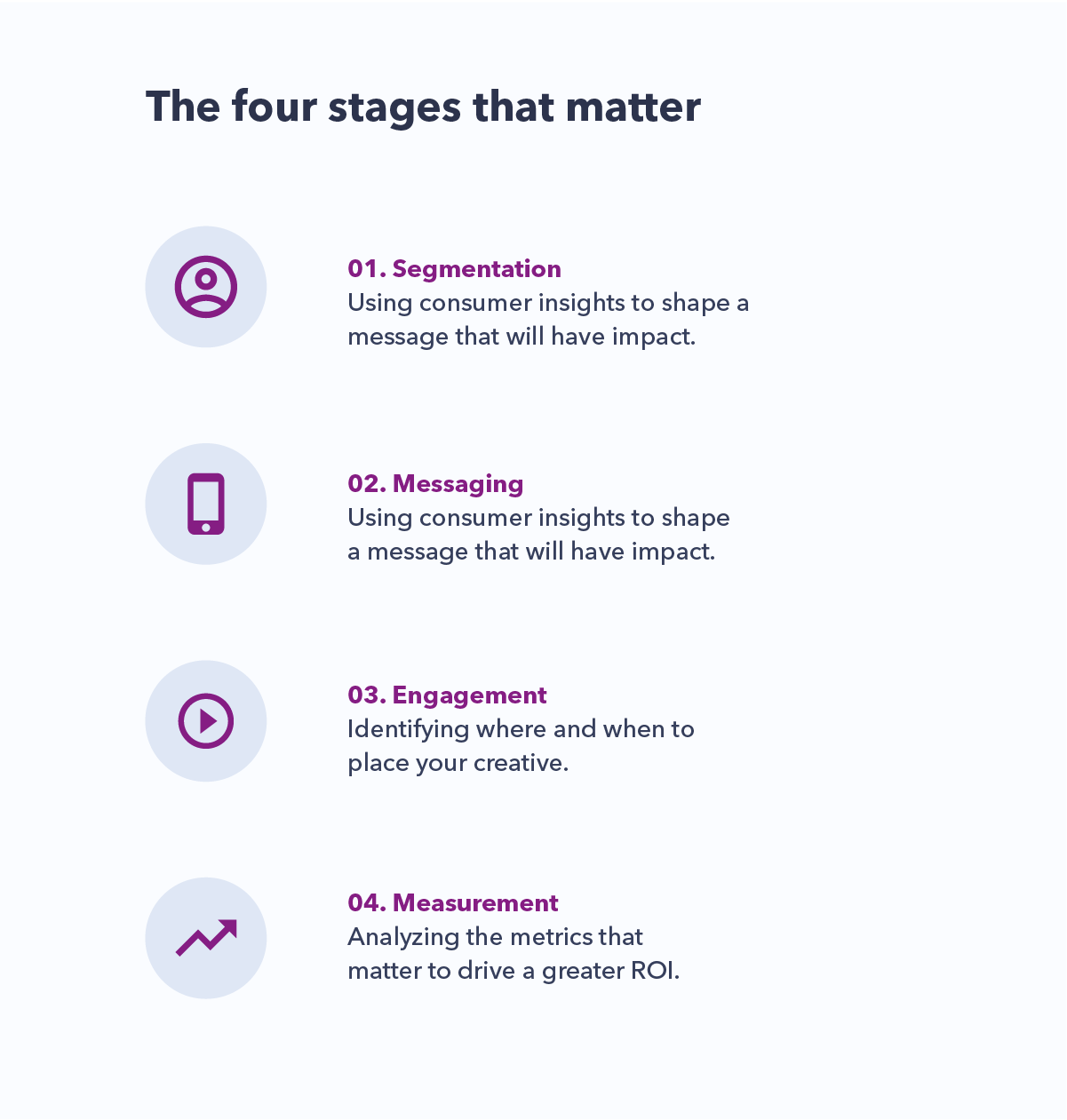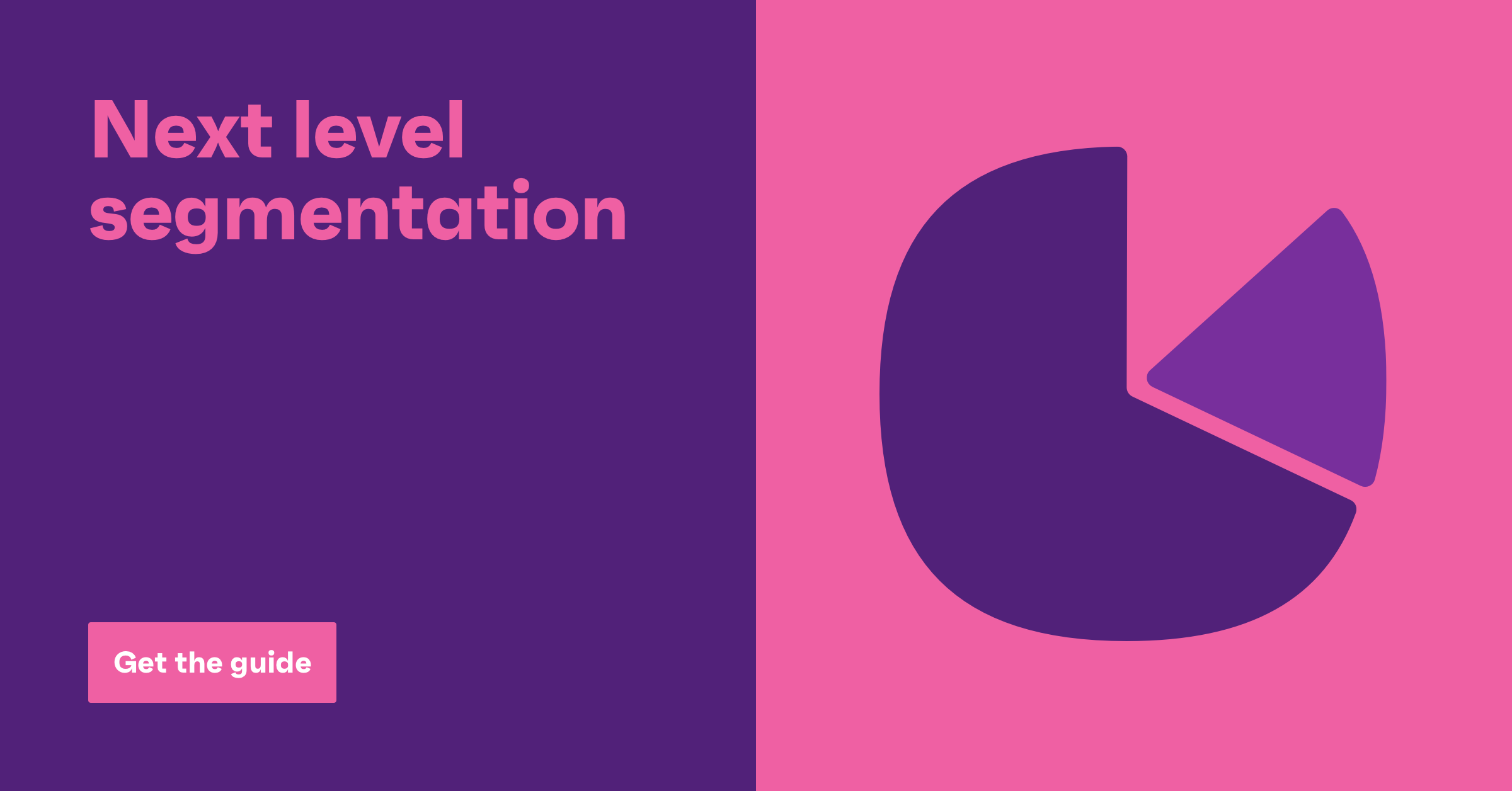Consumer insight has always been central to effective brand positioning and marketing strategy. Today, it’s taking on a whole new role. The reason for this is simple:
Consumers will no longer accept blanket messaging.
They expect more from brands; they want a personalized experience at every touchpoint that speaks to them, and them alone.
The demand for brands to tailor their marketing in this way has spurred the need for in-depth data that goes far beyond basic demographics, developing consumer and customer profiles based on their perceptions, interests, attitudes and behaviors.
Access to this data has eliminated the need for guesswork and paved the way for more data-driven creativity and decision-making.
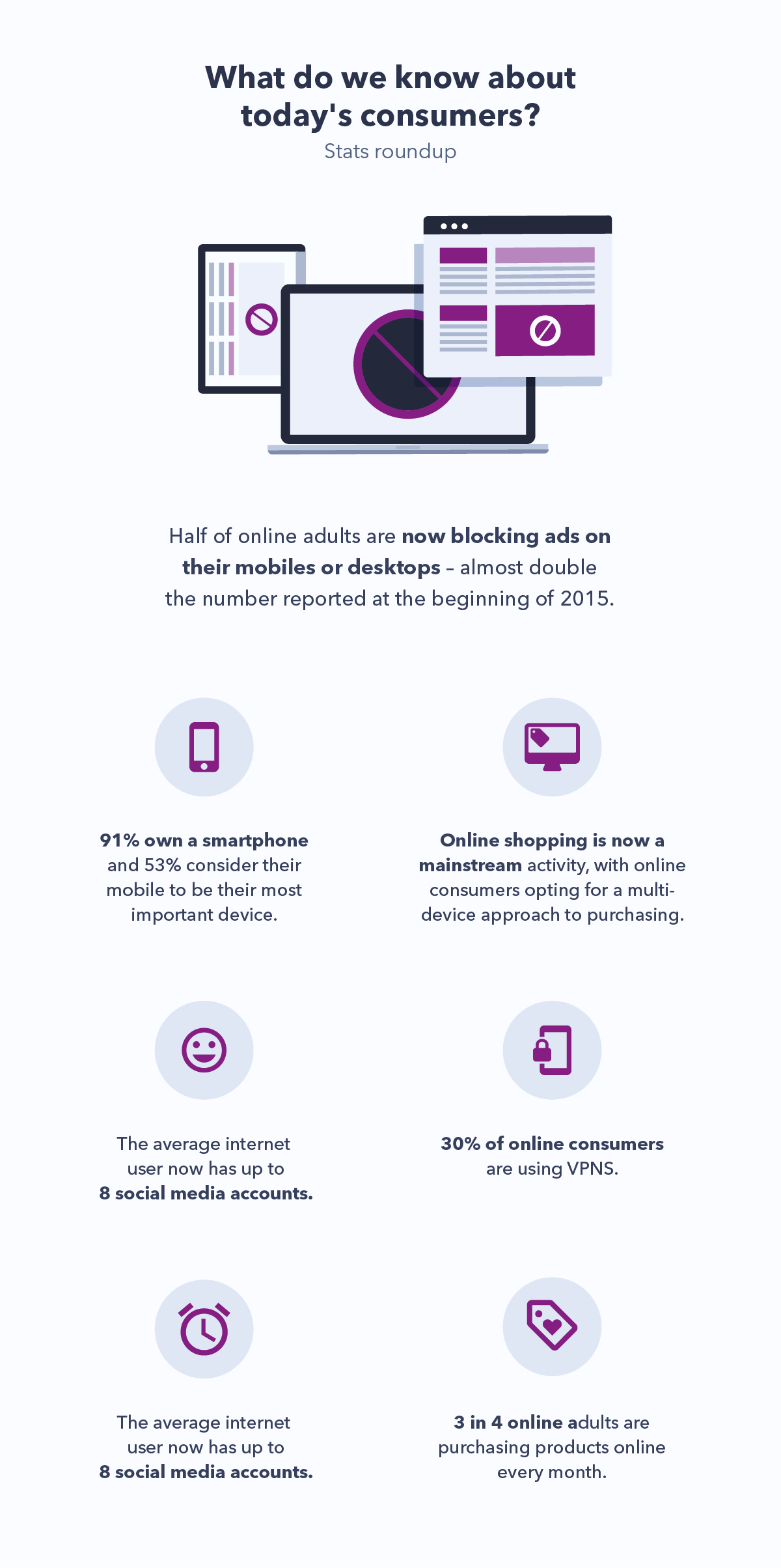
What does this tell us about our users or customers?
These facts tell us more than we may think. As they become more fragmented, and ever-more challenging to reach, digital consumers are also taking more control.
With the power to choose what advertising and marketing they’re exposed to, and when they’re exposed to it, they’re demanding more of what they want from brands, and less of what they don’t.
But this isn’t to say there’s less potential for marketers to reach them. In fact, it’s quite the opposite.
With more consumers now taking a multi-channel, multi-platform approach and spending increasing amounts of time online, the number of ways to connect with them is greater than ever.
What these facts outline is the need for a more consumer-centric approach to marketing and customer profiling - one that puts authentic branding at the forefront and respects an individual consumer’s right to tailored content that they genuinely value.
What is consumer profiling?
Consumer profiling (also referred to as "customer profiling") is the only way to gather the insights needed to identify, segment and define your target audience.
Going far beyond basic demographics, it means getting as close to your consumer as possible, so you can reach them the right way.
But the answer doesn’t lie in extensive research. It lies in good quality insight. And yes, there’s a difference.
Consumer profiling is about creating value from data to understand everything there is to know about your target consumers and the market that surrounds them.
Leading brands are putting insight in the driving seat to put consumers at the heart of their messaging, guiding everything from campaign planning to brand positioning.
This process starts with focusing on your current customers, followed by your desired target audience and target market, getting the validation you need that you’re looking at the right people.
Once you have this, it’s about understanding and defining these consumers to get your messaging right, focusing on the ideal customer insights that can drive meaningful creativity.
Why does it matter?
In 1984, Orvel Ray Wilson famously said:
"Customers buy for their reasons, not yours."
Understanding these reasons is more important today as marketing that works is personalized, adaptive and responsive to consumer needs.
As they move deeper into the digital space, consumers are becoming more confident and assertive about what they want from brands.
And as they splinter into more diverse segments that branch out across platforms, devices and channels, the need for personalization is becoming greater.
But personalized marketing isn’t just about offering ads based on that person’s purchase history and website interactions.
Profiling your consumers with revealing insights into their behaviors, perceptions, attitudes and interests helps you to paint a detailed portrait of your audience, so you know what to say, and how to say it.
“We as consumers, in an accelerated way, have become less open to interruptive ads and promotional messages," says Michael Brenner, CEO at Marketing Insider Group.
"Recent research from The Advertising Research Foundation shows that after a few dozen messages from one company, from one brand, sales start to decline. Instead of creating interruptive promotional messages that nobody wants to see and may even cause a decrease in sales, marketing professionals are starting to see that if they create the content people want, you can start to attract the audience that ultimately drives value.”
Marketing that works
Marketing and advertising professionals today are facing increasing demands and pressure from employers to prove their impact on the bottom line, and justify their everyday decisions with hard data.
For research and insights professionals, their roles have become even more pivotal to the teams around them.
They’re under more pressure to provide impactful consumer insights beyond just demographic information, as and when they’re needed, from a reliable source that paints a holistic picture of the target audience and offers a compelling competitive advantage.
But while marketing in the digital space is no easy feat, with a myriad of tools, techniques and sources to juggle, in its simplest form, marketing that works revolves around four key stages.
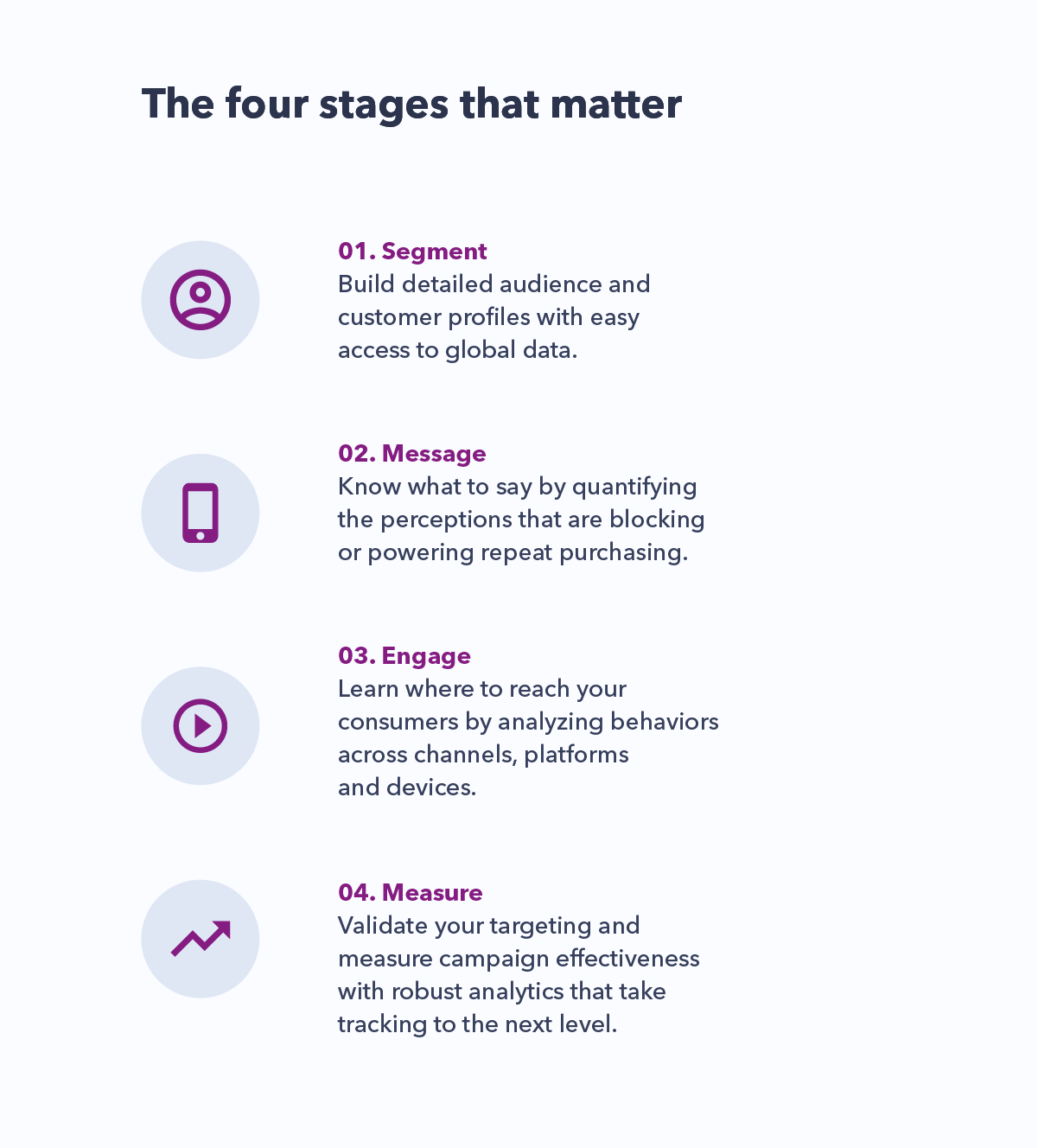
Questions your consumer data should answer
To put marketing that works into practice, you need consumer and customer data that will answer the right questions.
- Am I targeting the right audience?
- What defines this audience?
- What matters to them?
- What motivates them?
- What interests them?
- Who and what do they follow?
- Where and when can we reach them?
- What are their perceptions of our brand?
- What do we need them to perceive/understand?
- How are they interacting with us?
- What does their purchase journey look like?
- What are the touchpoints that matter?
- What trends can we identify with these consumers?
“Success lies in understanding deep down what motivates the consumer and what levers to press," says Sue Unerman, Chief Transformation Officer at MediaCom UK.
"And we have way more of those levers at our command now than ever before.”
Stage 1: Segmentation
Knowing your audience
Audience segmentation ensures your marketing is as targeted as possible to the right group of people.
Traditionally, market segmentation involved splitting consumers into groups based on basic demographic data like location, age or gender.
It was the starting point for any brand looking to better understand their audience and used to be the only way to drive more targeted campaigns.
Done right, audience and customer segmentation can be used to better understand your business and customers, and to attract new audiences. Nowadays, the process goes much deeper.
With the help of global data that allows for a true picture of consumer behaviors and perceptions on a massive scale, you can create intricately detailed profiles of your audience via segmentation.
These data-driven profiles include aspects like lifestyles, attitudes, self-perceptions and interests, making them more in-depth than ever.
So what exactly do these new segmentation techniques look like, and what does it take to get them right?
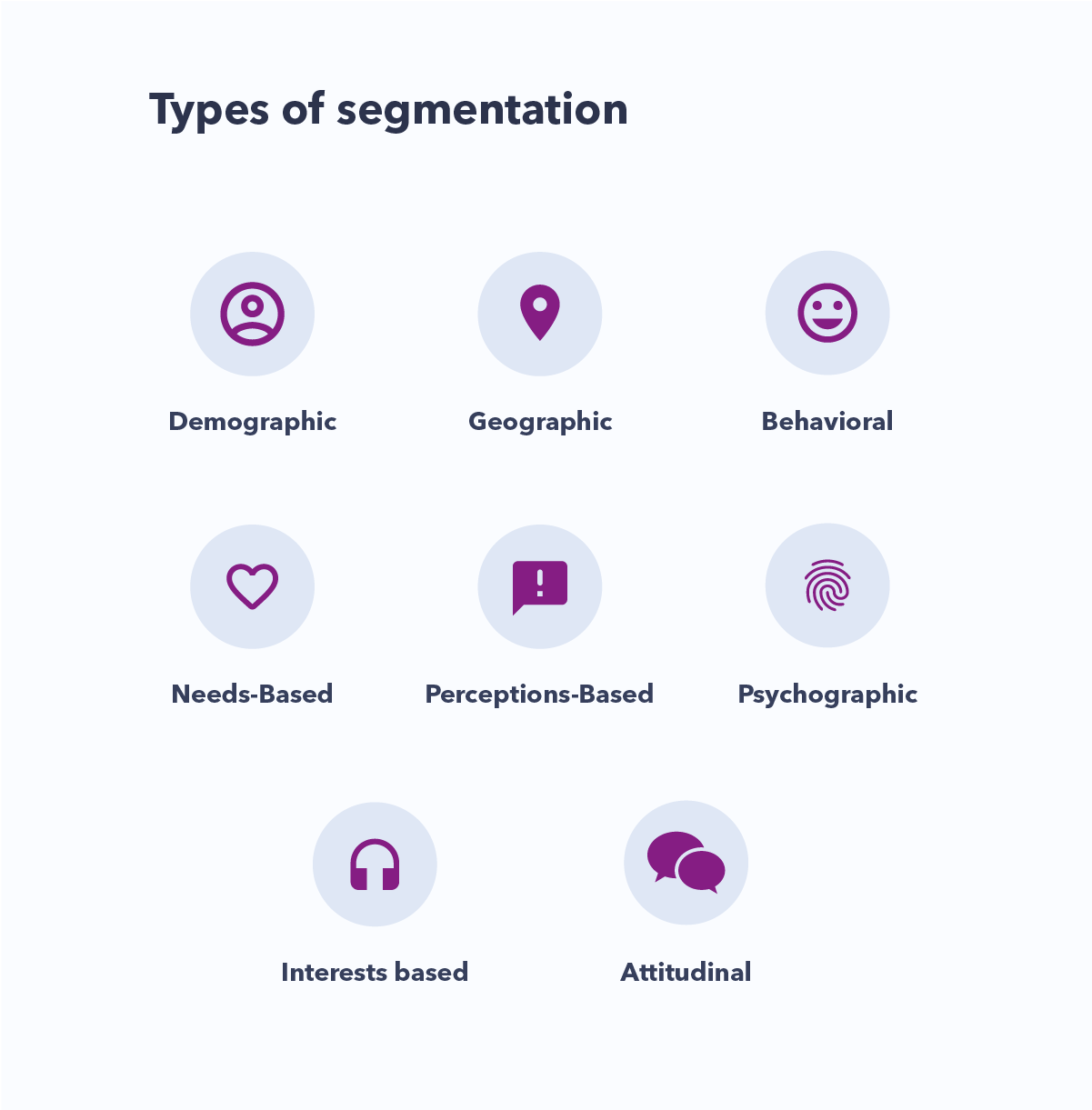
Segmenting your approach
With more types of segmentation in existence, knowing which approach will work for you is a challenge many businesses face when building customer segments.
By combining elements from each type of segmentation with valuable survey data and analytics, you can hit that sweet spot to uncover the insights that really matter.
Brand X, for example, might have a basic understanding of its target audiences, made up of key demographics and needs-based information, giving some direction on where to focus.
Complementing this with survey data around consumer perceptions, behaviors, interests and attitudes will take this approach from targeted to personalized.
By taking the many types of segmentation into consideration, personalization is made easy and targeting more on-point equipped with knowledge around the right channels, devices and language to use.
Here’s an example case study.
Insight in practice: Blis
|
The Challenge
As a leading provider of location data, Blis is a brand that continues to grow. Setting its sights on new markets further afield, the team needed access to reliable insights to support their research methods and help them understand the opportunities within.
Alex Wright, Head of Insights at Blis explains: "Almost every European market will have their own independent data sources. And when you go further than this, a lot of the sources and data are inconsistent and you don’t know the origins.” This lack of knowledge put barriers in place for the teams when it came to speaking to these prospective clients and solidifying their pitch. The Action In an effort to prove to existing and prospective clients they were willing to go above and beyond for them, they invested in GlobalWebIndex. This gave Blis ready access to deep consumer insight they simply couldn’t find elsewhere. “Before GlobalWebIndex, we could infer why people were doing certain things from their actions, but this meant we relied on people buying into the common sense nature of human behavior. For example, that if you go to a five-a-side match, you must have an interest in football.” “We lacked the active, declarative data we needed to understand consumers’ motivations for doing these things.” The Result By being proactive and introducing an external data to complement their own, Blis has positioned itself as a business that offers a comprehensive solution, and far more than just location data. Using insights it uncovered via GlobalWebIndex, the brand:
“This data has strengthened our relationships with our clients by showing them we’re willing to invest in additional sources to help us make more intelligent decisions on their behalf.” |
Creating data-driven buyer and consumer personas
Buyer personas have always played an integral role in the segmentation process. These real-life representations of your target audience give you a snapshot of who these people are, so you can tailor your marketing and brand strategy accordingly.
Creating personas with consumer profiling takes this to another level.
With data that gives you more than just a snapshot, you can create a detailed pen portrait of your consumer - mapping everything from a day in their lives to what the interests and attitudes that make them unique.
Using GlobalWebIndex, you can run instant queries against data representing over 2 billion consumers worldwide, pulling key stats that portray who your target audience is and what defines them.
These personas can be further with the help of real-life quotes gathered by carrying out interviews with your target consumers, or by inviting other client-facing teams within your organization to help fill in the gaps.
Once populated with the insights that best translate who these consumers are, your personas will form the basis of your segmentation - essential tools for your business to guide its marketing and brand positioning in the right direction.
“The first thing I do when I get given key attributes of a consumer is plug these into GlobalWebIndex and create a pen portrait; a one page document that translates the character of the consumer," says Tim Primrose, Planner at Southpaw.
"This really help me when I’m briefing our creative teams. I can explain who the consumer is, what makes them tick, what their priorities are in life, their behaviors, and other key areas such as their interests which are hugely Important.”
Mapping the consumer journey
The path to purchase may still revolve around some key stages, but the customer journey itself has changed dramatically. Consumers today are using multiple devices to learn, compare, share, consume and make purchasing decisions.
Increasingly, the journey spans a number of touchpoints - from websites to review sites and social media - with every single experience impacting a consumer’s decision.
But just as the journey becomes more fragmented, consumers continue to demand consistency.
This is a key challenge for brands under pressure to ensure a seamless customer experience - across channels, devices and platforms. To coincide with this consumer fragmentation, more targeted micro-audiences have emerged, urging a shift away from broad demographics-based targeting and sparring the need for more in-depth insights.
Mapping this journey with consumer profiling gives you the answers you need when it comes to identifying the touchpoints, the interests and the trends that can take a marketing strategy from targeted to personalized.
This means delving into the details of your micro-audiences; not just looking at moms, but moms between the ages of 20-35, for example, who are heavy online shoppers.
Profiling this audience using a range of data points including social media usage, media consumption and commerce, you can track every step of their journey to identify everything, from what matters least to what matters most.
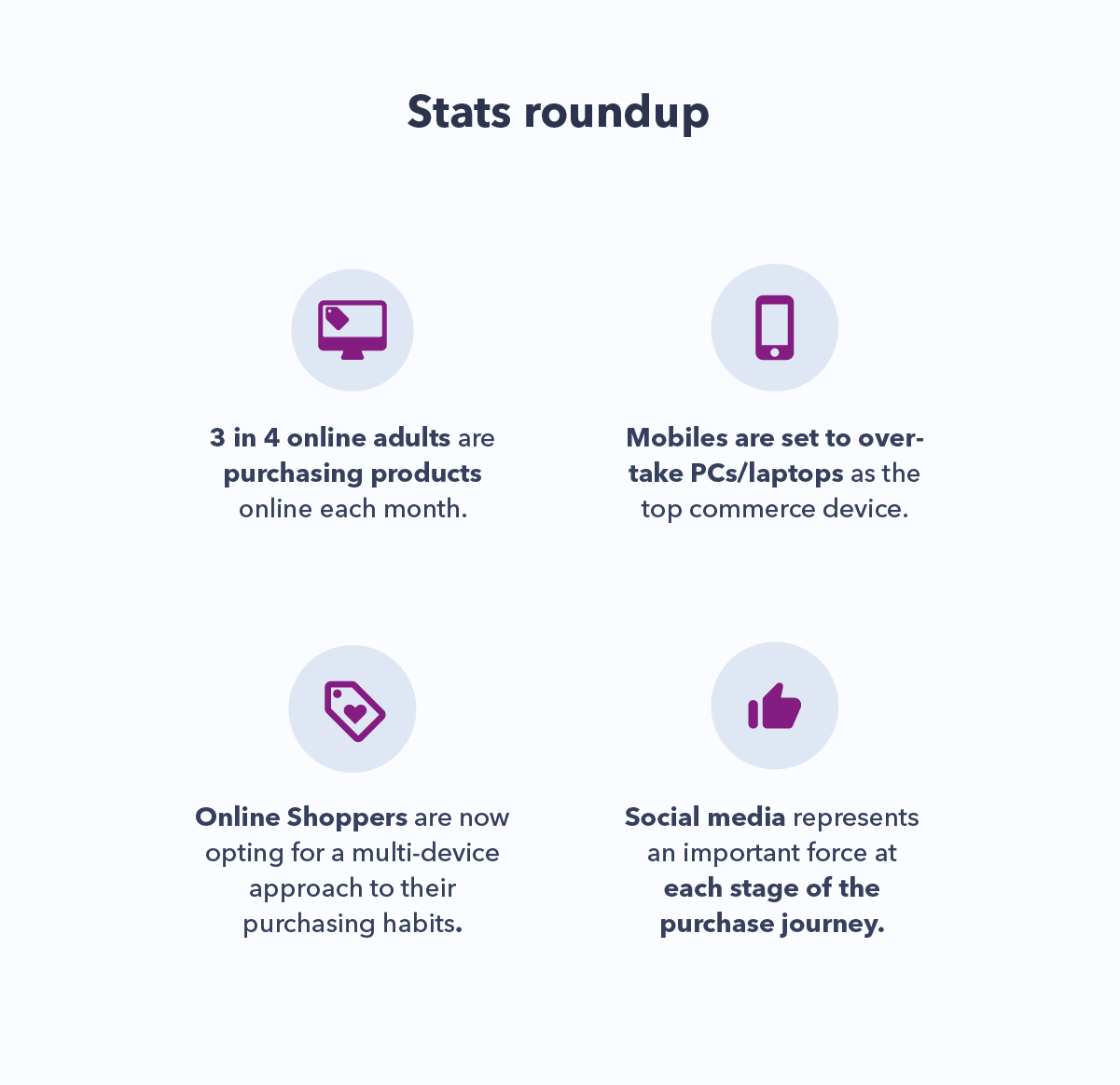
“Using GlobalWebIndex, we set up the profile first and then we go into more detail looking at that consumer’s activities and interests to analyze what he/she does most to what he/she does least," says Sharmin Rashid, Junior Strategist at Analog Folk.
"This information is so useful for creating a user experience, for example. One we created recently was for our UX team internally to help us understand what people are doing and how they’re using our platform, so this is an attempt to visually represent all of that.”
Audience spotlight
Gen Z vs. Millennials vs. Gen X
Millennials are an infamously difficult consumer group to analyze, spreading across several audience segments and categories.
While it can be tempting to assume that younger consumers make similar actions due to similar reasons, this simply isn’t the case.
Our data shows clear differences in how these three consumer groups interact with brands.

These findings clearly prove the need for deep segmentation, highlighting why it’s essential to understand why your segments demonstrate different behaviors.
Any brand looking to target one, or all, of these generational cohorts must adapt their strategy to suit the consumers.
With granular insight like this at hand, you can implement hyper-targeted marketing with confidence.
Stage 2: Messaging
Turning data into insight
Creating messages that resonate starts with understanding the perceptions and behaviors you want to shift. Using consumer profiling to quantify the perceptions that are blocking or powering repeat purchasing gives you the tools to know what to say.
Brands have access to a wealth of data, but giving this data the leverage it needs to drive meaningful creativity lies in the creation of insights. After all, a fact, a finding or a data point without context is worthless.
The path to creating actionable insights that will have impact lies in knowing your audience and your objectives and prioritizing your data accordingly. With this knowledge, you can focus on the data that will give you the answers you need, bringing the numbers to life.
What it takes:
- Analyze current perceptions of your brand.
How are my target consumers responding to my messaging?
- Validate the perceptions you’re trying to shift.
Does the data back up my assumptions?
- Quantify these perceptions.
What are the actual figures I need to focus on?
- Map this into a business opportunity.
How can this data help me to create an impactful message?
Creating ideas that stick
Al Ries once famously said:
“Marketing is not a battle of products, it’s a battle of perceptions.”
Understanding these perceptions and using insights to tap into them is the key to creating the ideas that stick. Many brands are leading the way when it comes to creating perceptions-led campaigns that hit home.
Lidl is one brand that proves the power that lies in understanding perceptions. Take their ‘Lidl Surprises’ campaign for example, released in July 2016.
Having uncovered the insight that most Brits still perceived the quality of their produce as low, the team knew which perceptions they needed to shift.
With this in mind, their messaging could take on its most consumer-centric form, with in-depth data giving them a glimpse into the interests, attitudes and desires they could tap into.
Uncovering the insights that count means getting to the root of how your consumers feel about your brand, your competitors and even themselves. This will inform everything from tone of voice, format and style to the message itself.
With GlobalWebIndex, you can profile your consumers in detail based on their perceptions and attitudes to create impactful insights, proven to drive marketing that works.
Stage 3: Engagement
Staying ahead of trends
With this level of audience understanding shaping the messaging that's sure to resonate, the next step is knowing where to place it. Engaging today's consumers means knowing where they are, and what they're doing.
With consumer profiling data that analyzes consumer behaviors across platforms, devices, channels and social platforms, you can figure out where, when and how to reach them.
Using the insights specific to your audience means elevating your voice in the right way, for maximum impact.
But consumer trends are continuously changing, so keeping an eye on those that bear the most relevance is key - from social media to device usage and commerce.
These trends not only tell you a lot about your consumers, but guide your marketing activity and brand strategy in the right direction by helping you to predict future behavior.
Start by browsing the latest reports that outline the most important trends to watch. From here, you can apply your audiences to get into more detail and identify those most applicable.
Tapping into these trends will give you the opportunity to boost engagement in more ways than one, by putting the science behind your ideas.
Behavioral science
Behavioral analytics is a science of learning. It looks at what consumers do online, how they act and react to content, brands and campaigns, and how they behave on different platforms and devices.
These insights enable marketers to make the right offers to the right consumers at the right time. The use of behavioral analytics by leading brands like Amazon have set the industry standard.
The brand uses data to personalize the online shopping experience to its consumers - and it works:
35% of Amazon.com's revenue is generated by its recommendation engine.
But analytics isn’t the only way to understand the science behind consumer behavior. Analytics and survey data work together to give brands a more accurate reading of what consumers are doing, and what they can leverage.
Using analytics to track how your consumers are interacting with your product/brand enables you to give recommendations, upsell and personalize your offerings.
Bringing survey data into the equation allows you to identify every touchpoint worth knowing - from which brands, content and influencers they follow online to which tactics they respond to most and why. This will ensure your approach has maximum impact.
Getting personal
With deep insights into your consumers’ behaviors - combined with those that quantify their perceptions, attitudes and interests - you can put personalization into practice, giving your target audience the content they want - when and where they want it.
Personalizing your communications this way - from your marketing communications to social media and advertising campaigns - means speaking directly to the consumers you want to reach.
Research from Accenture reveals 75% of consumers are more likely to buy from a retailer that recognizes them by name, recommends options based on past purchases, or knows their purchase history.
But for this kind of personalized marketing to work, access to accurate and fast insight is key.
Analytics solutions like GWIQ analytics that combine passive and active forms of measurement will give you the answers you need - tracking consumer behaviors using both panel research and web analytics.
This, along with data that translates your target consumer’s key motivations, interests, attitudes and perceptions helps you create tailored communications that resonate.
“I think if you were a publisher today coaching marketers, you would say: ‘We’ve been getting consumer attention for years with our content, and the only way that you’re going to do that is if you are genuinely useful, helpful or entertaining to them," says Joe McCambley, SVP Enterprise, Content Marketing at POP.
"For advertising and marketing in the content space to be successful, they have to do the same thing.”
Chapter 4: Measurement
Metrics that matter
It’s not always easy to attribute marketing activity directly to revenue results. But continually measuring and quantifying the impact of your efforts is essential to drive marketing that works.
Getting to the root of this means focusing on the metrics that matter; narrowing down your Key Performance Indicators (KPIs) to reflect your marketing and business objectives as closely as possible.
Depending on your specific goals that sit under the wider categories of awareness, consideration and conversion, your actions and KPIs should change accordingly.
Case in point:
- If building brand awareness is your primary objective, for example, your tactics might include an insights-driven campaign that spreads across TV and online media.
- Your KPIs for measuring its success could include a brand lift and a shift in perceptions and behaviors in response to your campaign.
- Measuring these KPIs might involve using brand tracking and carrying out an ad effectiveness study to quantify the impact of your campaign on your target audience.
Measuring campaign effectiveness
With insights that allow you to tweak, optimize, and repurpose your campaigns to better reflect your consumers, you can ensure a return on investment and prove your marketing is worth the spend.
But getting the answers you need is a key challenge - especially when it comes to social media, as measuring this kind of ROI continually proves to be a key challenge for today’s marketers.
This inability to track what matters comes down to the quality of marketing measurement tools in existence today.
While a combination of third party website and social media analytics can offer you the insights you need on a basic level, the many flaws of web analytics is well documented - and this comes back to an over-reliance on passive data and ‘probabilistic’ solutions.
Tracking people, not devices
The problem with most web analytics - like those used by marketers to track campaign performance and consumer interactions - is that these generally track devices (or cookies) as opposed to people.
With consumers becoming ever more fragmented, taking a multi-channel and multi-platform approach along the online purchase journey, it's becoming close to impossible to accurately measure and understand online behaviors using passive techniques alone.
In response to this problem, marketers and advertisers are turning to solutions like GWIQ Analytics, which couples extensive panel data with real-time analytics, to get a more holistic portrayal of audience behaviors - across time, location, devices and platforms.
Ensuring your marketing activity is tracked in the most accurate way takes this kind of robust tracking combining passive and active measurement techniques.
This closes the loop on consumer profiling, giving marketers the tools to measure their activity with reliable data that reflects real people.
“By our estimates, over 500 million users are absent or misallocated from passively collected data", says Tom Smith, CEO & Founder at GlobalWebIndex.
"These consumers are using Virtual Private Networks (VPNs), with hundreds of millions more being overlooked because they are only using shared devices or accessing the internet from mobile only.”
Conclusion
Consumer profiling is about defining, segmenting and profiling your target consumers to guide every element of your marketing and brand strategy.
Leading brands, agencies and publishers are proving the value that lies in data that quantifies consumer behaviors and perceptions in granular detail.
With the tools that eliminate the need for guesswork, a marketing strategy can meet consumer demand for consumer-centric content that’s targeted, personalized and responsive.
For those getting started, this guide outlines the importance of consumer profiling across all four core marketing disciplines and how it can be used across every stage of the funnel to truly understand your audience.
For brands, this means driving smarter content, better quality leads, improved customer experience, and a greater ROI.
As consumers move further away from blanket messaging towards brands who prove they’re listening, investing in data that tells you more about your audience is not only worth it, it’s essential.
About GlobalWebIndex
As home of the world’s largest survey on the online consumer, the GlobalWebIndex platform makes it easy to create powerful insights that move.
Our data represents over 2 billion internet users across 45 countries, quantifying attitudes, behaviors, perceptions and interests across 35,000 data points.